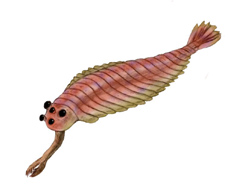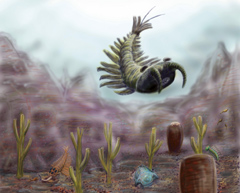
Campus Moncloa
Campus of International Excellence
Cambrian
541-485 M.a.
Cambrian derives its name from rock outcrops in an area of the United Kingdom which the Romans called Cambria.

Pannotia has broken up into four continents: Laurentia (approximately America and Greenland), Baltica (approximately Northern Europe), Siberia and Gondwana. The latter is a supercontinent containing South America, Africa, India, Australia, Antarctica and much of Asia and Europe, including the Iberian Peninsula.
In a short period of time, in geological terms, an explosion of life occurs. The main groups of marine invertebrates appear: arthropods, molluscs, brachiopods, annelids and the first jawless vertebrates, among others. Many of them fossilise well because they have shells and have left us characteristic fossils like trilobites or archaeocyathids.

Opabinia, a marine arthropod specimen.

Reproduction of Cambrian fauna.
| Hadean | ~4600-4000 M.a. |
| Archean | 4000-2500 M.a. |
| Proterozoic | 2500-541 M.a. |
| Cambrian | 541-485 M.a. |
| Ordovician | 485-443 M.a. |
| Silurian | 443-419 M.a. |
| Devonian | 419-359 M.a. |
| Carboniferous | 359-299 M.a. |
| Permian | 299-252 M.a. |
| Triassic | 252-201 M.a. |
| Jurassic | 201-145 M.a. |
| Cretaceous | 145-66 M.a. |
| Paleogene | 66-23 M.a. |
| Neogene | 23-2,6 M.a. |
| Quaternary | 2,6 M.a.-act. |
